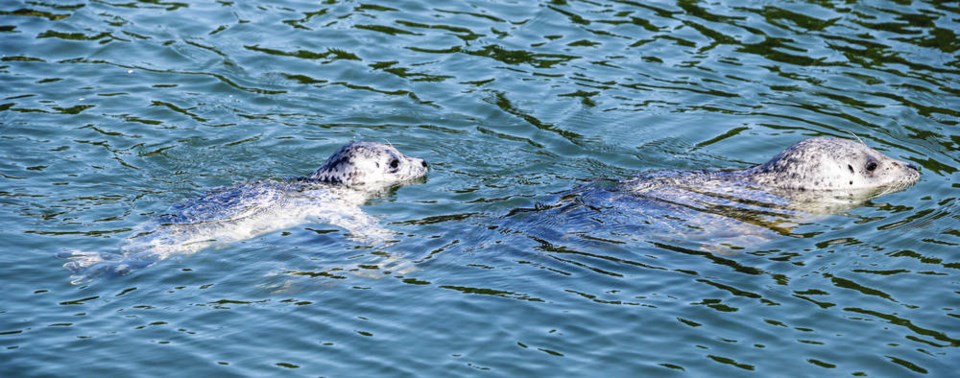Southern resident orcas are among the most contaminated marine mammals in the world.
They are highly contaminated by polychlorinated biphenyls (PCBs) in particular, which affect the whales’ physical and brain development, immune system and reproductive health.
Ocean Wise and the Environmental Law Centre at the University of Victoria reported in 2020 and 2019, respectively, that out of 51 sites sampled up and down the coast, Victoria Harbour contains the highest concentrations of mercury and toxins such as PCBs, dioxins, flame retardants and plastic stabilizers. The results are based on data from Ocean Wise’s PollutionTracker, a tool that monitors contaminants in the marine environment along sa���ʴ�ý’s coast.
Although our harbour isn’t considered critical orca habitat, the toxin concentrations may affect other species. These include some endangered Pacific salmon the endangered orca feed on. In addition, some salmon may feed on other species that spend part of their lives in our harbour.
I’ve seen signs of herring running in the Gorge, and every year, volunteers count the coho returning to spawn in Colquitz Creek. Crabs, shrimp, oysters, and other invertebrates, as well as fish can also be found sheltering in our harbour.
Adult chum eat fish, mollusks and other marine invertebrates. Chinook eat insects and crustaceans when they’re young and other fish as they grow older and larger.
In 2016, Seattle-area researchers found over-the-counter and prescription medications, cocaine and other illicit drugs in the tissues of juvenile chinook in Puget Sound. Estuary waters near the outfalls of the region’s sewage-treatment plants were cocktails of more than 80 drugs and personal-care products.
To determine what the drugs might be doing to the fish, the researchers undertook another study. They regularly fed fish food treated with chemicals to the same levels found in the Puget Sound estuaries.
The results, reported in the journal Environmental Pollution in 2018, weren’t good. The fish grew more slowly, and their metabolisms were so disrupted the fish seemed starved. Blood tests showed that the disruption continued long after the chemical feeding finished.
The response was particularly pronounced in chinook salmon, a species southern resident orcas depend on.
What is found in inland waters would also affect fish swimming in them. For example, Czech researchers found recently that brown trout kept for eight weeks in water laced with trace amounts of methamphetamine similar to levels found in European rivers downstream of cities showed signs of meth addiction.
When the researchers transferred the fish to uncontaminated water and offered a choice between clean or meth-laced water, the meth-exposed trout selected the drug-laced water — behaviour that suggests addiction.
The fish were also less active than trout that had never experienced the drug. The researchers found evidence of the drug in the fishes’ brains up to 10 days after the methamphetamine dosing stopped.
Meth and cocaine may not accumulate in fish tissues nor move up the food chain as PCBs and similar toxins do. Drug addiction, however, might drive fish to gather near wastewater discharge outfalls in search of fixes, as well as disturb their natural life habits and disrupt population health.
All Pacific salmon start their lives in freshwater. Coho spend at least one winter in freshwater before moving out to the ocean, and sockeye and steelhead spend one to three years in rivers, streams and lakes before heading to the saltwater.
Chinook vary, with some moving oceanwards within weeks of hatching and others remaining in freshwater for up to two winters.
Most southern sa���ʴ�ý rivers pass through sewage-discharging cities and towns that carry chemical and drug loads.
This means many sa���ʴ�ý salmon are exposed at a young age to whatever we flush, whether it’s what we throw out, throw up or dump into our toilets. And if the salmon are exposed, southern resident orcas are likely affected, directly or indirectly.
The Capital Regional District’s new sewage treatment facility, which began operating in December, provides tertiary treatment before the wastewater is discharged two kilometres out in the strait. Tertiary treatment is one of the highest levels of contaminant-reduction processes and is used to further reduce substances such as metals, organic chemicals and nutrients such as phosphorus and nitrogen.
Depending on the specific processes in place in a facility, it can also reduce the amount of pharmaceuticals and personal care products in the wastewater.
It would be interesting to know how it is helping to reduce the stew of drugs and chemicals the region’s salmon and orcas are exposed to.



